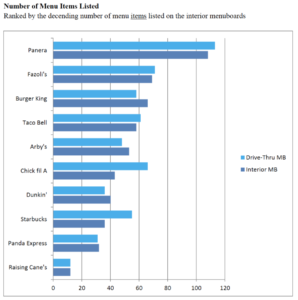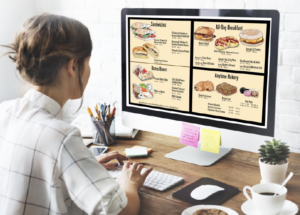
As competition grows stronger for QSR and fast-casual restaurants, many restaurant brands attempt to become everything to all customers by expanding its menu and allowing for endless combinations and customizations. But this increase in menu board complexity is one key factor of many that can cause a slow down in the kitchen, a decrease in order accuracy, an increase in service times and a decrease in throughput.
While QSRs and fast casuals alike work to improve these four main restaurant table stakes – order accuracy, speed of service, customer service – through various tools and strategies like AI, mobile applications/mobile ordering and suggestive selling, studies show that much improvement can be made simply by simplifying and updating the menu board design.
In fact, 74% of customers say that an easy-to-read menuboard is a top priority. 2019 Menuboard Survey Report conducted by SeeLevel HX and King-Casey
Yet with roughly 50 items on average on a QSR or fast casual menu board, it becomes clear that there is plenty of room for improvement.

Top 10 Menu Board Best Practices
To realize increased sales and a greater ROI in your restaurant, take these top menuboard design best practices from the 2019 Menuboard Survey Report into account.
1. Research
Conduct attitude and usage research to determine how customers perceive and use your menu.
2. Assess
Undertake a TURF analysis to assess which combination of products, services and pricing will allow you to appeal to the greatest number of customers.
3. Develop
Develop a menu strategy that prioritizes menu items based on their contribution to your business objectives.
4. Prioritize
Give prominence to your most profitable products in the “hot spots” of the menuboard – the places where customers tend to look first.
“Menuboard optimization is one of the best investments my company can make. It far exceeds almost any other strategy I could pursue to increase sales and profits.”QSR CEO
5. Analyze
Conduct a space-to-sales analysis to determine the amount and prominence of space given to specific menu categories and items.
6. Rank
Rank current and new products by sales, margin and operational complexity.
7. Clarify
Clarity is king! Too much information can be a negative.
8. Limit
Limit combos offerings to no more than 8-10 (see #6).
9. Test
Use quantitative research to virtually test alternative menuboard strategies to determine the best strategy. Then test the “winning” strategy in actual stores.
10. Support
Use “staged messaging” to support the menuboard and influence desirable sales.
Focus on Restaurant Table Stakes
The key to many of these best practices is that your restaurant cannot be everything to everyone. Menuboard complexity has taken a toll on service times, order accuracy, kitchen throughput and more. If you’re ready to improve restaurant table stakes and step ahead of your competition, it might be time to look inward and optimize your menu board design.
For the more menu board tips and statistics, and to discover where your restaurant stands against your competitors, download the 2019 Menuboard Survey Report.


